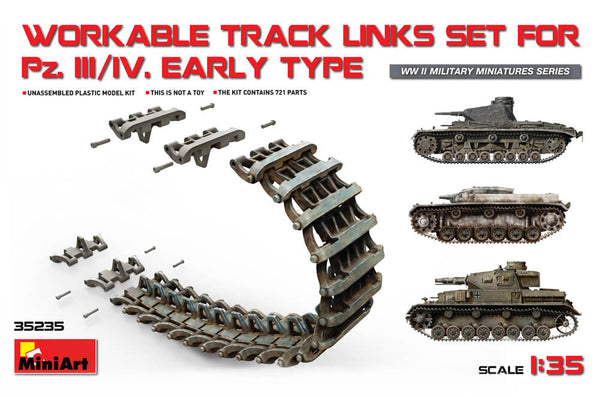HobbyBoss 1:35 AAV-P7A1 Assault Amphibious Vehicle (w/ Mounting Bosses)
82413
Sold Out
The U.S. Assault Amphibious Vehicle (AAV, or AAV-P7/A1) is the current amphibious troop transport used by the U.S. Marine Corps Assault Amphibian Battalions. It is a fully tracked amphibious landing vehicle equipped with an MK19 40mm grenade launcher and an M2 HB CAL 50 machine gun.
Item No: 82413
Item Name: AAV-P7A1 w/mounting bosses
Item Type: Static kit
Model Dimensions: Length 233mm, Width 94.2mm, Height 93mm
Total Plastic Parts: 803 pcs
Total Sprues: 20 sprues, lower hull, upper hull, 192 track links
Chromeplate Parts: n/a
Camouflage Scheme: United States Marine Corps Assault Amphibian Battalions
Resin Parts: n/a
Metal Parts: n/a
Photo Etched Parts: two frets
Film Accessory: n/a
Release Date: 2008-10
Additional:
- Fully detailed interior
- Multi-directional slide moulded lower hull
- The entry door can be fixed in an open or closed position
Related Items
Miniart 1:35 - Pz.Kpfw III/IV Early Type Track Links
Sold Out
Miniart 1:35 - Pz.Kpfw III/IV Early Type Track Links - Plastic model kit #35235
These workable track links are suitable for the following tank models:
Pz.Kpfw. III Ausf.A
Pz.Kpfw. III Ausf.B
Pz.Kpfw. III Ausf.C
Pz.Kpfw. III Ausf.D
(Each track link contains 96-98 tracks)
Stug III Ausf.A
Pz.Kpfw. III Ausf.E
Pz.Kpfw. III Ausf.F
(Each track link contains 94 tracks)
Pz.Kpfw. IV Ausf.A
Pz.Kpfw. IV Ausf.B
Pz.Kpfw. IV Ausf.C
Pz.Kpfw. IV Ausf.D
Pz.Kpfw. IV Ausf.E
(Each track link contains 101 tracks)
The kit contains 721 parts for the assembly of Pz.Kpfw III/IV track links.
Box: 260mm x 162mm x 35mm
Meng Model 1:35 - King Tiger Sd.Kfz.182 (Henschel Turret)
Sold Out
Meng Model 1:35 - King Tiger Sd.Kfz.182 (Henschel Turret) - Plastic model kit #TS-031
The Tiger II was a German heavy tank of WW2. Its official German designation was Panzerkampfwagen Tiger Ausf. B, often shortened to Tiger B. It is also known under the informal name Königstiger ("Bengal Tiger"), often translated as King Tiger or Royal Tiger by Allied troops. The initial design of the Tiger II was developed in 1937 by the Henschel company. Another design was developed by Porsche in 1939, but it was declined due to higher production costs.
Based on the Tiger I, the Tiger II combined the thick armour of its predecessor and the sloped armour of the Panther medium tank. The tank weighed almost seventy tonnes, it was protected by 100 - 180mm of armour at the front, and was armed with the long barrelled Kampfwagenkanone 8.8cm 43 L/71 gun which proved to be efficient against all Allied tanks.
The Tiger II first saw combat during the Battle of Normandy in 1944. Fortunately for the Allies, German plants were severely disrupted by Allied bombing, so a relatively small number of Tiger II's were built. Mass production ran from 1944 to the end of the war and only 492 units were produced during that period.
The kit includes parts for the King Tiger Sd.Kfz.182 heavy tank with two different gun mantlets.
Academy 1:35 German Pz. Kpfw. VI Tiger I (Early version, with interior)
Sold Out
Academy 1:35 - German Pz. Kpfw. VI Tiger I (Early version, with interior) - Plastic model kit #13239 (Replaces ACA01348)
The Tiger I, a German heavy tank of World War II, was deployed from 1942 in Africa and Europe commonly in independent heavy tank battalions with the designation Panzerkampfwagen VI Tiger Ausf. E often shortened to Tiger. The Tiger I gave the Wehrmacht its first armoured fighting vehicle that used the KwK 36 88-mm gun. In total 1,347 were built between August 1942 and August 1944. Production was over time phased out in favour of the Tiger II.
The Tiger I has been called an excellent design for its time, however it was over-engineered, using expensive materials and labour-intensive production methods. The Tiger was prone to some types of track failures and breakdowns, and had limited range given its high fuel consumption. It was expensive to run, but normally mechanically reliable. It was also difficult to transport, and vulnerable to immobilisation when mud, ice and snow froze between its overlapping and interleaved Schachtellaufwerk-pattern road wheels, often causing them to jam. This was a problem on the Eastern Front in the muddy rasputitsa (semi-annual mud seasons) and winter weather conditions.
The tank was named "Tiger" by Ferdinand Porsche, and the Roman numeral was added after the later Tiger II entered production. The early designation was Panzerkampfwagen VI Ausführung H (‘‘Panzer VI version H’’, abbreviated PzKpfw VI Ausf. H) where 'H' denoted Henschel as the designer/manufacturer. It was given ordnance inventory designation SdKfz 182. The tank was later redesignated as PzKpfw VI Ausf. E in March 1943, with ordnance inventory designation SdKfz 181.
Tigers had a crew of 5. They could travel up to 23mph on roads and were powered by the Maybach 21, 353cc V-12 engines that delivered 642hp.
HobbyBoss 1:35 - Pz. Kpfw. I Ausf. A (Early/Late)
Sold Out
The Panzerkampfwagen I was a light tank developed in Germany in the run-up to WWII. Abbreviated Pz. Kpfw. I, the tank was officially designated Sd.Kfz.101.
As Germany was restricted by the Treaty of Versailles in its military capability, the first tank prototypes were produced under the code name Landwirtschaftlicher Schlepper which meant 'Agricultural Tractor'. The prototypes were armed with two 7.92 mm MG 13 machine guns and were used as training vehicles by German armed troops.
The Ausf. A was the first combat vehicle of the Panzer I series. Its thin armour and suspension problems resulted in weak performance on the battlefield. However, the improved versions were in military service during all German campaigns between 1939 and 1941 including the Invasion of Poland and the Battle of France.
Although the Panzer I models were of little use against even the lightest tanks of that era, they contributed significantly to the development of German military production.
Item No: 80145
Item Name: Pz. Kpfw. I Ausf. A Sd.Kfz.101 (Early/Late)
Scale: 1:35
Item Type: Plastic Model Armour Kit
Release Date: 2016-09



































